Back from the wilderness
Updated: 2017-08-22 By Zhao Xu (China Daily)  Print
Print 



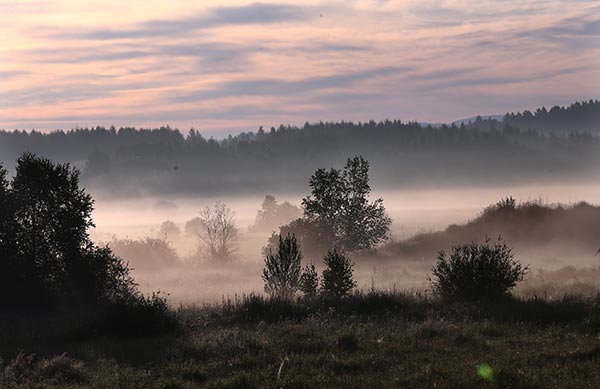
One summer morning in July Saihanba National Forest was immersed in mist. [Photo by Zou Hong/China Daily]
The mid-summer morning is shrouded in white, every mountain crevice filled with this milky mist that overflows from plateau lakes clearly too shallow to hold it all.
I am in Saihanba, China's largest national forest, to see and learn about the epic, often tragic, effort that has gone into transforming this once desolate expanse into hectare upon hectare of lush green forest. But before I can even contemplate that task the sheer majesty of the place sweeps me off my feet.
At Seven-Star Lakes, located in the central-west of the forest and whose name refers to seven small patches of water in the area, I let that beauty and the flower-perfumed cool morning air seep deep into me.
I have been here since 5.40 am, about 40 minutes after sunrise, and millions of golden beams penetrate the mist before bouncing on the lake surface. The interplay between the light, water and the mist is a wonder to behold and is ever-changing, resulting in multiple layers of color floating above the surface of the lakes.
For me, who had spent seven hours the previous day traveling from Beijing to this paradise in Hebei province, the view more than compensates the fatigue and car sickness I had endured. All around are young people waving cameras.
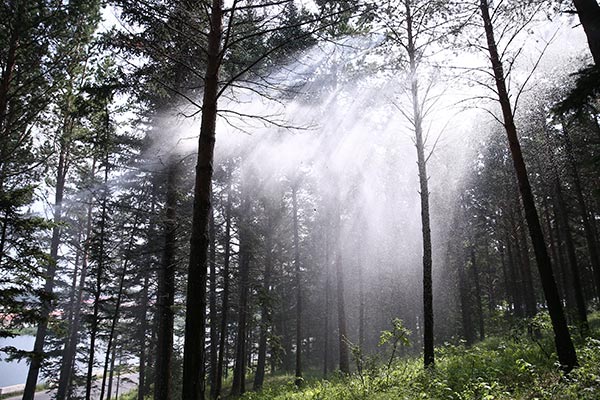
The conifer trees stand vigilant at Saihanba. [Photo by Zou Hong/China Daily]
A photographer accompanying me who was here two hours before me tells of the magnificent sunrise: the sky-and the lakes that reflect it-was flushed by a blend of crimson, fuchsia and ochre as the dark blue receded to usher in a new day.
Everything here is sculpted by sunlight, from a blade of grass to the mountains and trees in the far distance. By 7 am the mist has largely dissipated, and the warm sun pours a bucket of golden dye into the water, and onto the anglers who sit at the lakeside. Saihanba has arisen.
Although the forest is officially located in Hebei, its northern edge borders China's Inner Mongolia autonomous region, which gives the place a strong Mongolian flavor. For one thing, in Mongolian Saihanba means "beautiful highland".
In history, the place has consistently lived up to that designation, first becoming a royal hunting ground in the early 10th century. That was when the Liao Empire, set up by a nomadic people, ruled vast tracts of land in northern China. Saihanba, with its lush forests and boundless grassland, was where successive Liao emperors continued their tradition of spring and autumn hunting, chasing wild geese with their specially trained birds of prey.
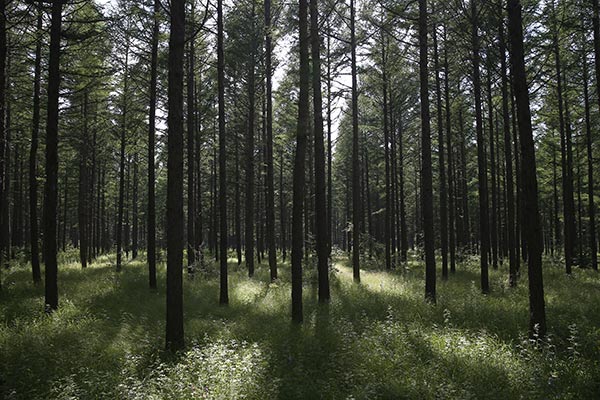
Sunlight pours into the forest at Saihanba. [Photo by Zou Hong/China Daily]
Later Saihanba experienced its heyday during the Qing Dynasty (1644-1911), China's last feudal dynasty. The founders were Manchu people, one of the two ethnic minority groups that have ruled the whole of China. Also a horseback people, the Manchu picked up their Liao predecessors' hunting practice and turned the place into the world's largest royal hunting ground.
Enclosure hunting was carried out: soldiers wearing deer horns sneaked into the forest before starting to blow whistles made of birch bark. The sound resembles that of a female deer, enough attraction for the male deer and the animals who preyed on them.
That lasted for another century and a half, until the fortunes of the empire began to wane, in the early 19th century. Western powers were pounding on the door of the Middle Kingdom, which meant the days for its rulers to pamper themselves in the name of their ancestors were gone. Royal hunting ceased in 1820, and in 1860 the hunting ground was opened to the public. Farmers and herders moved in, grass was grazed and trees felled. Over the coming decades the land was reduced to a shadow of its former self, and as its beauty vanished, Saihanba became the land people forgot.
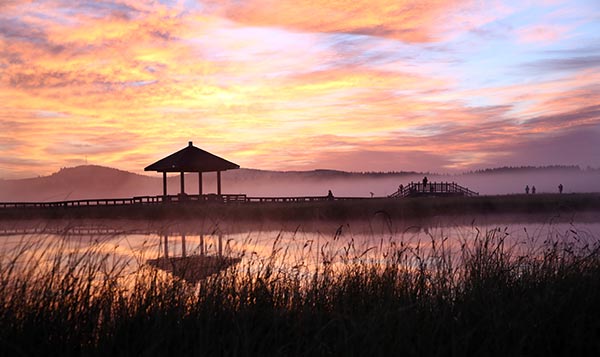
Early morning at the Seven-Star Lakes. [Photo by Zou Hong/China Daily]
It would not draw widespread public attention again until the 1950s, having become a passageway through which sandstorms blew, carrying their payload for hundreds of kilometers. Thus in 1962 the Chinese government decided to build a national forest there.
Those who lived there over the next few decades would have to withstand utter isolation and the bitter cold, but by 1982 their travails had borne fruit, the land being covered by 64,000 hectares of forest, which has since grown to 69,000 acres.
At the height of summer this vast expanse is a sight to behold, a seemingly endless green carpet that is astonishingly uniform rolling across the land, with single species of trees, including conifer, Scots pine, birch and spruce each allotted their own patch over which to hold sway.
In the autumn the vivid green that has spilled into every corner morphs into a combination of gold, ochre and dark green. For those who love pictures and photography, all the color, dripping and saturated, is a heady, addictive mix.
But that beauty is fleeting; when winter, for which Saihanba is renowned, arrives, all the visual noise is silenced. Most of the trees lose their leaves and the full intricacy of their branches becomes apparent. Autumn's blanket of leaves gives way to a blanket of snow, a white, spotless, spectacle all of its own.
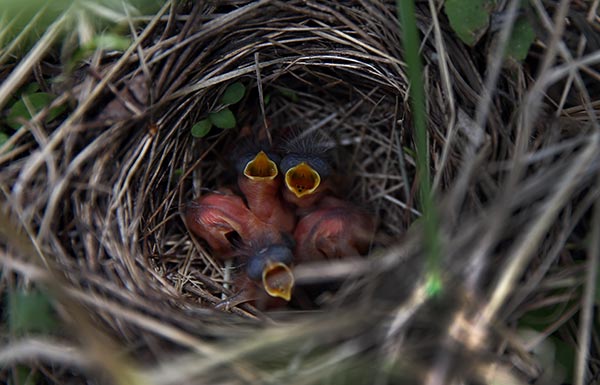
A nest of newborn birds. [Photo by Zou Hong/China Daily]
Cycle of life
Far away from the rushed cacophony of the city, the cycle of life here is so tangibly felt and honored by all who call it home.
At one poignant moment of my too-short visit I and my group almost literally stumbled upon a nest of newborn birds, whose maker had ingeniously built it with twigs barely hidden in the grass on the ground. A mother seemed to have worked out that sometimes it is in the most conspicuous place that safety lies.
The birds were so heartbreakingly young that they were devoid of feathers, with only pink, transparent skin as a covering. Their eyes firmly closed and mouths agape, they called incessantly for their mother, which, a forester said, must not be far away, in fact probably standing on a tree branch overlooking us.
"She comes down every half hour to feed her chicks," he said.
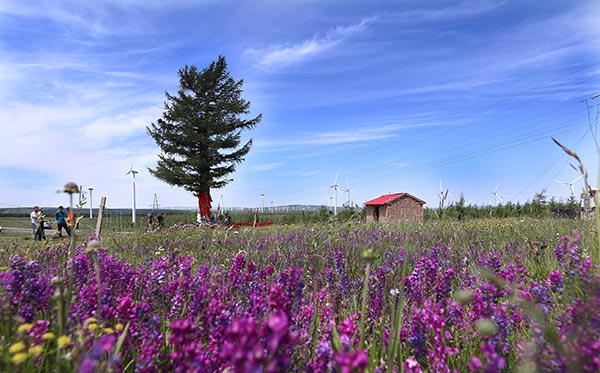
The Tree, a tree believed to have convinced researchers to build a national forest at Saihanba. [Photo by Zou Hong/China Daily]
On his advice we left, fearing our presence was impeding the mother in her parental duties. However, just before we left, this gentle man, who said he had been keeping an eye on the fledglings for several weeks, carefully readjusted the surrounding grass so as to better shield the birds from the sun.
In bygone centuries this place was a paradise for animals. Emperor Kangxi (1654-1722) of the Qing Dynasty, a consummate archer and the first Qing emperor to hunt at Saihanba, is said to have captured 318 rabbits in a day. Today the mature forests have coaxed back wild animals including deer, wild ducks and boars.
But most of the animals are shy. The only time I saw one was at Seven-Star Lakes, when a wild duck suddenly jumped out of the wetland in front of me and glided for a short while before diving back into the tall grass.
However, as our bus headed along the road between patches of farmland with forested mountains as their backdrop it was evident that many scarecrows dot the potato fields.
"We do have boars here," the driver said. "By day they hide in the forest, and by night they come out for potatoes."
Another place of beauty at Saihanba is where the forest park bor-ders Inner Mongolia, and where several rivers originate before running through a myriad of terrains towards places including Beijing and neighboring Tianjin.
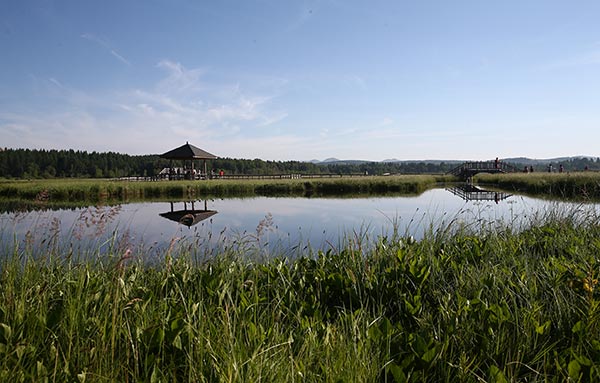
[Photo by Zou Hong/China Daily]
Improved environment
The improved environment has been conducive to the birth of animals previously thought to be extinct. One of these is the fine-scaled fish, which inhabits the chilly waters of plateau lakes.
Among the flora is a yellow flower the locals dry in the sun to make a medicine for treating inflammation of the throat, and a purple flower that outsiders often mistake for lavender. In northern Saihanba is a stretch of land filled with that little purple flower. Right beside it is a tree, about 20 meters tall and known, very matter of factly, as The Tree. Locals reckon that just before the national forest was founded in 1962 Liu Kun, an official of the State Forestry Administration, came to do ground research and saw that tree.
"At the time, the tree was estimated to be 150 years old," said Chen Zhiqing, a member of the forest's management. "The sight of that old tree, standing solitarily on the sandy ground, convinced him that a forest could be built here."
If the estimates are right, that tree has long since blown out the candles on its 200th birthday, and it still continues to enjoy relative solitude. But all around it forests have appeared.
Liu died in 2013 and asked that his ashes be scattered in the forest.
"People come here to escape the summer heat, and to be awed by the green 'ocean' around them," Chen said. "What few realize is that the way this beauty has been created is infinitely more inspiring than the beauty itself."





 Ordos Impression
Ordos Impression Ordos WeChat
Ordos WeChat Ordos Reported
Ordos Reported
